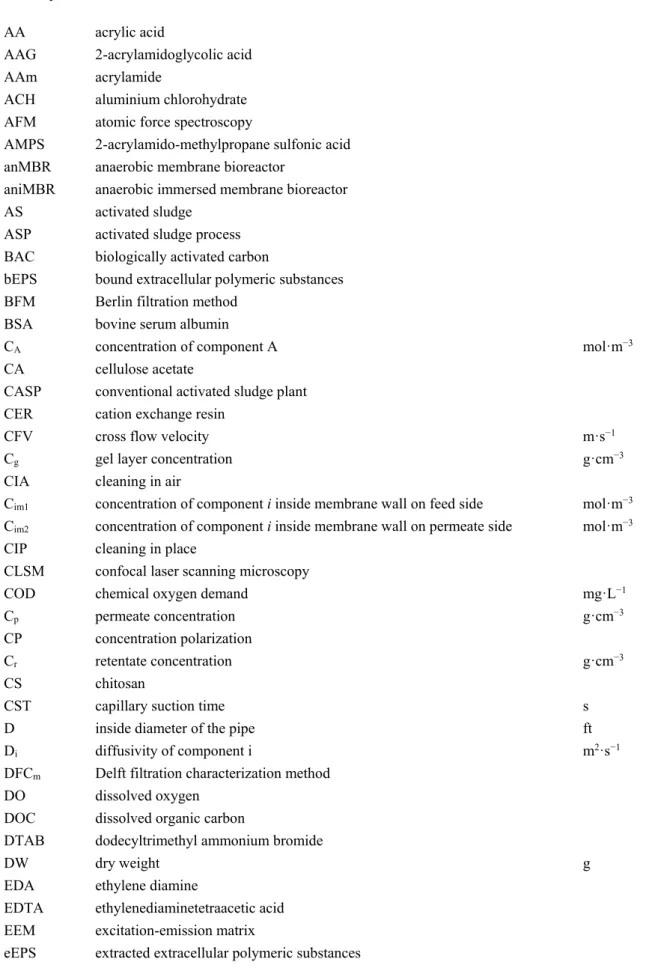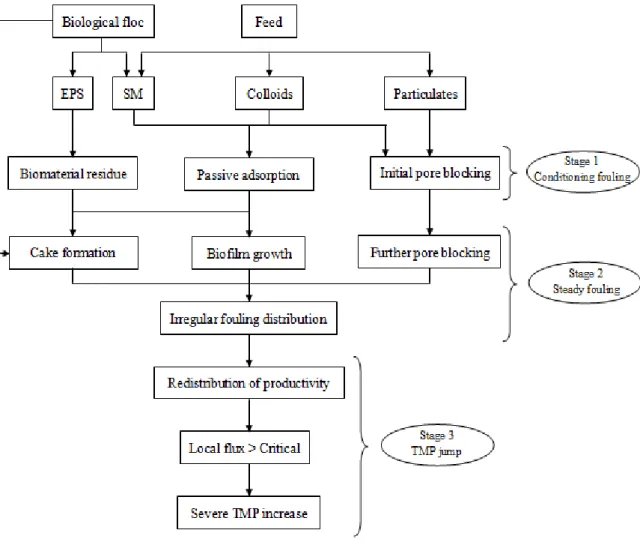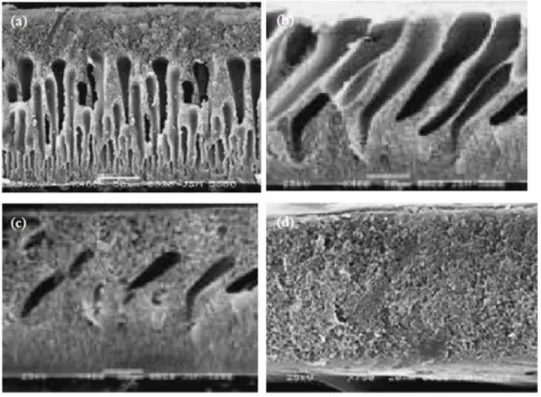All of the above contribute to membrane fouling, and (a) and (b) are promoted by concentration polarization (CP). Chang and Lee [5] experimentally found that a 40% reduction in EPS (by cultivating activated sludge under nitrogen-deficient conditions) resulted in an equivalent reduction in cake hydraulic resistance. Amelioration of clogging is primarily through strict feedwater screening and, especially for the HF configuration, limiting the particulate concentration in the membrane tank.
This again depends on both the flux and the residence time of the sludge in the membrane channels, as the degree of dewatering increases with longer residence times. Agglomeration must also depend on both the concentration and the properties of the particles, as it can be expected that particles which, for whatever reason, stick more easily to the membrane and/or to each other, will agglomerate faster. Due to the low critical flux measured for SMP solutions, further adsorption and deposition of organic substances on the membrane surface can also occur during Phase 2.
With regions of the membrane more polluted than others, the permeability at these specific locations is significantly lower. Advanced characterization of the biofilm formed on the membrane surface has been the basis of many studies. Efforts have focused on two main areas: (a) the use of state-of-the-art visualization techniques to study biofouling/biofilm morphology and (b) the identification of the microbial community present in the biofilm.
In terms of community analysis, methods such as fluorescence in situ hybridization (FISH) and polymerase chain reaction denaturing gradient gel electrophoresis (PCR-DGGE) are commonly used to study the nature of the microbial population and structure on the membrane surface. .
![Figure 1. Concentration polarization. Reproduced with permission from Reference [81]](https://thumb-eu.123doks.com/thumbv2/pdfplayerco/300227.41522/8.893.258.641.188.418/figure-1-concentration-polarization-reproduced-permission-reference-81.webp)
Prevention and Control Strategies
The addition of the electric field has significant effects on the membrane flux of the new MBR: particle electrophoresis will increase;. Therefore, an increase in membrane surface hydrophilicity is often a key goal for reducing membrane fouling by organic pollutants and microorganisms. Due to the formation of hydrogen bonds, a thin layer of confined water exists on the surface of the hydrophilic membrane.
This coating can prevent or reduce unwanted adsorption or adhesion of contaminants to the membrane surface. In addition, most colloidal particles, such as NOM, that deposit on the membrane surface are negatively charged [280]. As a result, a cross-linked PVA gel layer was formed on the surface and in the pores of the modified membranes.
However, for membranes with wider pores, PSS permeation leads to the formation of charged groups on both the surface and the pore walls of the membrane. This is due to the deposition of the chitosan both on the surface and in the pores, which leads to the prevention of BSA adsorption. It has been shown that the improved fouling resistance and the increased surface hydrophilicity compensate for the reduction in the membrane permeability due to the adsorption deposition of the PEI layer on the membrane surface.
This was explained by the increased hydrophilicity and the charge of the active membrane layer. Generally, plasma treatment of the membranes can be carried out in three different ways: (i) with non-polymerizable gas molecules; (ii) with polymerizable vapors; and (iii) with plasma-induced grafting of the polymer chains to the membrane surface, where the plasma treatment with non-polymerizable gases and plasma-induced grafting are the most widely used [282]. The increase in fouling resistance is believed to be due to the higher hydrophilicity of the modified membrane surface [55].
To improve the performance of the DS5DL (Osmonics) NF membrane, it was immersed in 1% w/v hydrofluoric acid (HF) for 14 days. One is the deposition of nanoparticles on the membrane surface by immersing a porous support in an aqueous suspension of nanoparticles [350]. As a result, a thin modified layer with immobilized nanoparticles was obtained on the surface of the PES carrier.
It was shown that the entrapment of TiO2 nanoparticles in the membranes increased the hydrophilicity of their surfaces. The inclusion of nanoparticles at ultra-low concentrations in the membrane had a decisive effect on the characteristics and filtration efficiency of the modified membrane.
![Table 2. Classification of fouling. Reproduced with permission from Reference [13].](https://thumb-eu.123doks.com/thumbv2/pdfplayerco/300227.41522/27.893.79.816.803.1009/table-2-classification-fouling-reproduced-permission-reference-13.webp)
Conclusions
Control of membrane fouling in an anaerobic membrane bioreactor coupled to online ultrasonic equipment for the digestion of waste activated sludge. Feasibility of using ultrasound for online monitoring of membrane fouling in an anaerobic membrane bioreactor. Interpretation of fouling characteristics of ultrafiltration membranes during the filtration of mixed liquid from the membrane bioreactor.
Influence of the filtration models on colloid adsorption on the membrane in submerged membrane bioreactor. The correlation of TMP increases with microbial features in the biocake on the membrane surface in a membrane bioreactor. Influence of the viscosity of the suspension and colloidal particles on the permeability of the membrane used in the membrane bioreactor (MBR).
Comparison of nitrification performance and microbial community between submerged membrane bioreactor and conventional activated sludge system. Properties of extracellular polymeric substances (EPS) and their effect on membrane fouling in a submerged membrane bioreactor. Membrane fouling in a submerged membrane bioreactor (MBR) under subcritical flux operation: Characterization of membrane fouling and gel layers.
Comparison between a submerged membrane bioreactor and a conventional activated sludge system for the treatment of ammonia-containing inorganic wastewater. Comparison of the filtration characteristics between attached and suspended growth microorganisms in submerged membrane bioreactor. Comparison of sludge characteristics and performance of a submerged membrane bioreactor and an activated sludge process at high solids retention time.
Potential and limitations of the addition of alum or zeolite to improve the performance of a submerged membrane bioreactor. Effect of powdered activated carbon on the performance of an aerobic membrane bioreactor: comparison between cross-flow and submerged membrane systems. The role of a membrane performance enhancer in a membrane bioreactor: a comparison with other submerged membrane hybrid systems.
Investigation of the influence of the electric field on membrane flux of a new type of membrane bioreactor. In situ manipulation of critical flux in a submerged membrane bioreactor using variable aeration rates and effects of membrane history.


![Table 1. Foulant definitions. Reproduced with permission from Reference [10].](https://thumb-eu.123doks.com/thumbv2/pdfplayerco/300227.41522/16.893.88.813.390.765/table-1-foulant-definitions-reproduced-permission-reference-10.webp)

![Figure 4. Fouling and cleaning. Reproduced with permission from Reference [3]. Copyright 2009 Elsevier](https://thumb-eu.123doks.com/thumbv2/pdfplayerco/300227.41522/29.893.252.646.188.592/figure-fouling-cleaning-reproduced-permission-reference-copyright-elsevier.webp)

